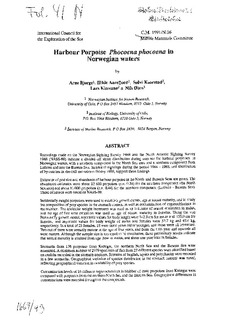| dc.description.abstract | Recordings made on the Norwegian Sighting Survey 1988 and the North Atlantic Sighting Survey
1988 (NASS-89) indicate a divided off shore distribution during summer for harbour porpoises in
Norwegian waters, with a southern component in the North Sea area and a northern component from
Lofoten and into the Barents Sea. Incidental sightings during the period 1964 - 1988, and distribution
of by-catches in the drift net salmon fishery 1988, support these findings.
Estimates of pod size and abundance of harbour porpoise in the North and Barents Seas are given. The
abundance estimates were about 82 600 porpoises (c.v. 0.24) for the southern component (the North
Sea area) and about 11000 porpoises (c.v. 0.44) for the northern component (Lofoten- Barents Sea).
These estimates were based on NASS-89.
Incidentally caught porpoises were used to establish growth curves, age at sexual maturity, and to study
the composition of prey species in the stomach content as well as contamination of organochlorines in
the blubber. The testicular weight increment was used as an indicator of sexual maturition in males,
and the age of first time ovulation was used as age of sexual maturity in females. Using the von
Bertalanffy growth model, asymtotic values for body length were 142.3 cm for males and 155.9 cm for
females, and asymtotic values for body weight of males and females were 52.7 kg and 49.4 kg,
respectively. In a total of23 females, 18 were three years old or younger, and these were all immature.
Two out of three were sexually mature at the age of four years, and from the fifth year and onwards all
were mature. Although the sample size is too small to be conclusive, these preliminary results indicate
that sexual maturity is attained from age three in males, and about one year later in females.
Stomachs from 176 porpoises from Kattegat, the northern North Sea and the Barents Sea were
examined. A minimum number of 2979 specimen of fish from 27 different species were identified based
on otoliths recorded in the stomach contents. Remains of hagfish, squids and polychaetes were recorded
in a few stomachs. Geographical variation of species distribution in the stomach content was noted,
reflecting geographical variation in availability of prey species.
Contamination levels of 16 different organochlorines in blubber of male porpoises from Kattegat were
compared with porpoises from the northern North Sea and the Barents Sea. Geographical differences in
concentrations were recorded for eight of the compounds. | no_NO |
